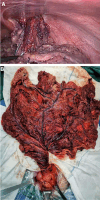Strangulated inguinal indirect hernia as a cause of secondary torsion of the greater omentum: A rare case report and literature review
- PMID: 40725969
- PMCID: PMC12303477
- DOI: 10.1097/MD.0000000000042511
Strangulated inguinal indirect hernia as a cause of secondary torsion of the greater omentum: A rare case report and literature review
Abstract
Rationale: Omental torsion is a rare surgical acute abdomen. Due to the lack of specific clinical manifestations and atypical symptoms, preoperative diagnosis is very difficult, and it is often confused with acute abdomen caused by other reasons. Secondary omental torsion caused by the incarcerated hernia is extremely rare.
Patient concerns: A 40-year-old male patient was admitted to the hospital on January 1, 2020, due to "nonrecoverable mass in the right inguinal region for 6 hours." The patient had a history of right inguinal hernia for 5 years and denied a history of abdominal trauma or surgery. Physical examination: normal vital signs, slightly distension in the abdomen, light tenderness in the whole abdomen, obvious in the right lower abdomen, accompanied by light rebound tenderness, weak bowel sounds. A mass of about 5 cm × 5 cm × 6 cm can be touched in the right inguinal region, with medium texture and obvious tenderness.
Diagnoses: Secondary omental torsion caused by an incarcerated inguinal hernia on the right side.
Interventions: Laparoscopic exploration.
Outcomes: The patient recovered well and was discharged on the 8th day after surgery.
Lessons: Omentum torsion is a rare disease that is difficult to diagnose preoperatively, and surgeons should raise awareness of it. Detailed medical history consultation, careful physical examination, combined with auxiliary examination, can help to reduce misdiagnosis.
Keywords: acute abdomen; diagnosis; incarcerated hernia; omental torsion; treatment.
Copyright © 2025 the Author(s). Published by Wolters Kluwer Health, Inc.
Conflict of interest statement
The authors have no conflicts of interest to disclose.
Figures
Similar articles
-
Hemorrhagic necrosis of omental cysts misdiagnosed as torsion of ovarian cysts: a case report and literature review.BMC Womens Health. 2025 Jul 14;25(1):345. doi: 10.1186/s12905-025-03893-y. BMC Womens Health. 2025. PMID: 40660240 Free PMC article. Review.
-
Transabdominal pre-peritoneal (TAPP) versus totally extraperitoneal (TEP) laparoscopic techniques for inguinal hernia repair.Cochrane Database Syst Rev. 2024 Jul 4;7(7):CD004703. doi: 10.1002/14651858.CD004703.pub3. Cochrane Database Syst Rev. 2024. PMID: 38963034 Free PMC article.
-
A Rare Case of Idiopathic Omental Necrosis in a Young Adult: Diagnostic Challenges and Management.Med Arch. 2025;79(3):237-240. doi: 10.5455/medarh.2025.79.237-240. Med Arch. 2025. PMID: 40657337 Free PMC article.
-
Omental torsion secondary to right inguinal hernia: case report and cumulative review of the English literature.Int Surg. 2007 Jul-Aug;92(4):187-91. Int Surg. 2007. PMID: 18050824 Review.
-
Diagnostic challenges and surgical options for cysts of the canal of Nuck in adults: Two cases report.Medicine (Baltimore). 2025 Apr 25;104(17):e41980. doi: 10.1097/MD.0000000000041980. Medicine (Baltimore). 2025. PMID: 40295299 Free PMC article.
References
-
- Rangarajan M, Palanivelu C. A rare cause of acute of acute abdomen due to primary omental torsion: value of laparoscopy in diagnosis and treatment. Hellenic J Surg. 2016;88:102–5.
-
- Efthimiou M, Kouritas VK, Fafoulakis F, Fotakakis K, Chatzitheofilou K. Primary omental torsion: report of two case. Surg Today. 2009;39:64–7. - PubMed
-
- Eitel GG. Rare omental tumor. Med Rec. 1899;55:715–6.
-
- Zaleta-Cruz JL, Rojas-Méndez J, Garza-Serna U, González-Ruvalcaba R, de Elguea-Lizarraga JO, Flores-Villalba E. Omental torsion: case report. Cir Cir (English Edition). 2017;85:49–53. - PubMed
Publication types
MeSH terms
Grants and funding
LinkOut - more resources
Full Text Sources
Medical


